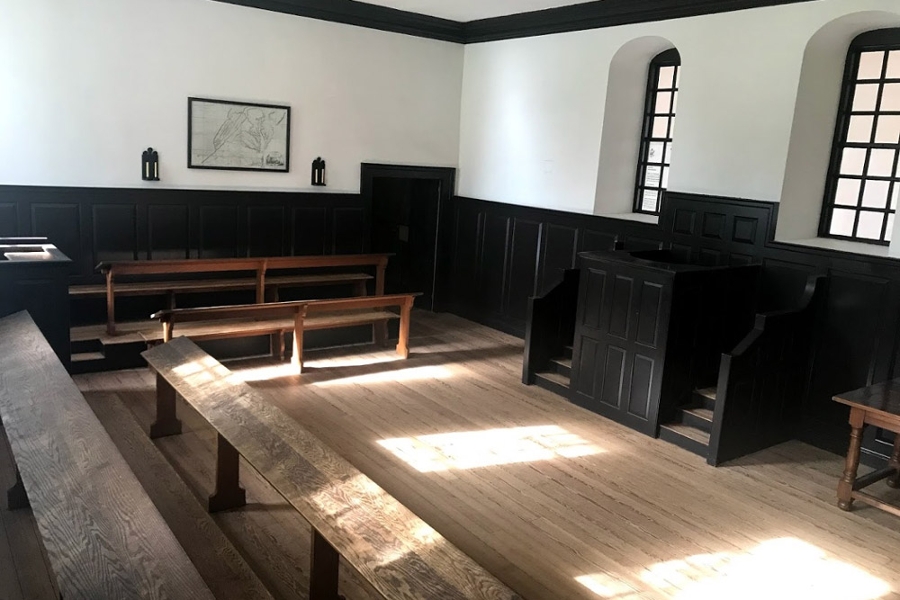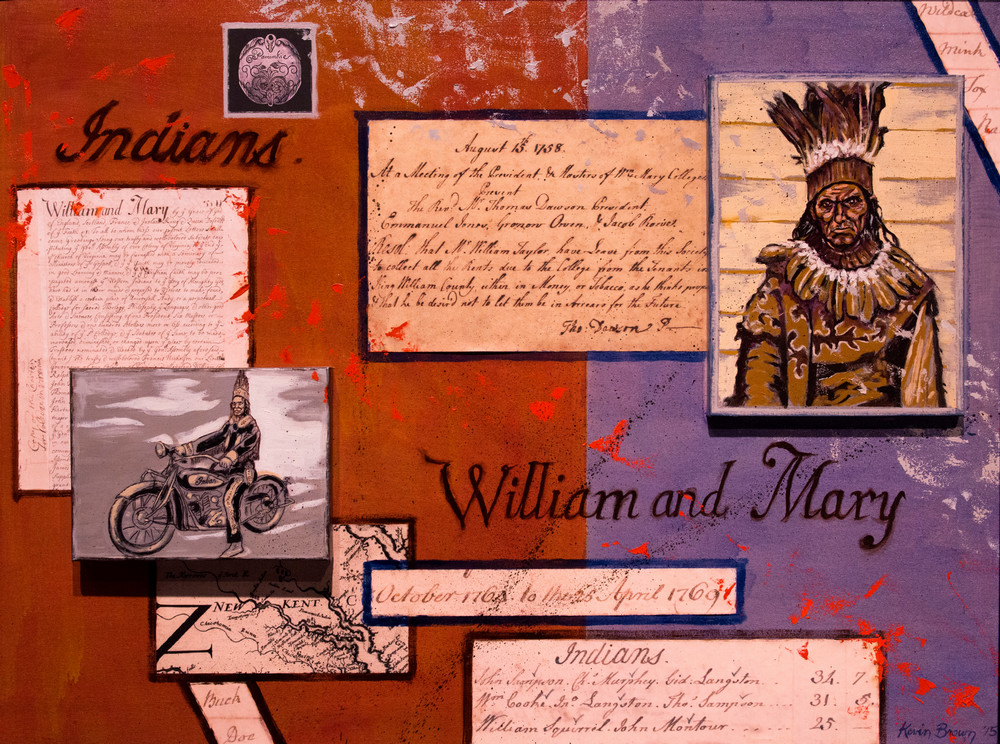The Early Decades of the Brafferton Indian School
c. 1700–1740
Employing his authority as the Commissary of the Bishop of London in the Colony of Virginia, the Rev. James Blair worked tirelessly to seek approval for “the founding [of] a Colledge in this Country.” Blair’s efforts on both sides of the Atlantic were successful in obtaining funding and a royal charter for an Anglican College in Virginia, which would be named for the English monarchs, William and Mary. Blair also garnered funding from the estate of scientist Robert Boyle which were used to purchase the Brafferton Manor in Yorkshire, England in 1695. The Boyle Charity purchased the Brafferton Manor for £5,400, a significant sum of money in the seventeenth century. Rents from the extensive agricultural property were used to educate, clothe, house and board Native youths at the new school. Named for the Brafferton Manor in Yorkshire, the Indian school would carry the name of its primary funding source and be known as the Brafferton Indian School.
Funding the school and filling the school with Native students were separate challenges. Shortly after the chartering of William & Mary, colonial officials encouraged those tribes who were signatories to treaty agreements, also known as treaty Indians or tributaries, to send some of their young men to the college.
In an era of enslavement and servitude Native communities experienced fear and mistrust regarding the safety of their community members. Tribal leaders, even among those who negotiated treaties with the English, were reluctant to bring their young males to the colonial capital. The request to bring “Indian boys” to Williamsburg for instruction at the new school was met with silence and inaction.
In 1700, to assuage tribal concerns, Virginia Governor Francis Nicholson encouraged the tributaries to inspect the school, and he promised that the Indian students would “have very good usage,” be taught “to read, write & all other arts & sciences, that the best Englishmen’s sons do learn.” The Governor assured tribal leaders that Indian students would have “good valuable clothes, books & learning” and be given adequate care “both in health & sickness,” “& all upon free cost.” Nicholson asked the tributary tribes to send a few boys each, aged seven or eight years old and no more than four from “any one Great nation,” for a total of possibly ten students at the college.
Moreover, Governor Nicholson encouraged tribal communities to send “a careful Indian man of their own country to wait upon” any prospective students and gave his word that no Indian students would be enslaved. In doing so, Nicholson attempted to address the concerns of the tribal leaders, suggesting that they send adult attendants “to serve” the “sons” of chiefly families, thus offering insurance of the boys’ protection. Native students having an adult chaperone and fellow young kinsmen “to talk continually with them in their language” would ensure “they do not forget” how to speak properly “whilst they are amongst the English.” Despite Nicholson’s overtures, local Native leaders remained skeptical and feared they would never see their children again if they brought them to Williamsburg and left them in the care of school officials.
Given Nicholson’s efforts to convince tribal leaders it was safe to send their sons to the Indian School it is ironic that the first students at the Indian School (c. 1702) were procured by Indian traders, who purchased or acquired four young Indian captives from the Catawba Nation. Robert Hicks (or Hix) and John Evans, Indian traders to the “Usheree and Totero” (also known as the Catawba and Tutelo), secured the four captives alongside the deerskins and fur pelts trucked overland from the Indian towns to James River warehouses. The boys, who were unnamed prisoners from more distant southern tribes, were likely destined to be sold by the Catawba as forced laborers to the colonists. Instead, Nicholson’s Indian agents traded goods for the four young boys and the Governor placed them at the college. While little is known about these first Native students at the College, they were not kept as slaves in Williamsburg. Having lost all memory and association with their natal communities it is likely they remained institutional wards at the Indian School for many years.
Eventually, the fears of the tributary tribes were overcome, and Native students were sent to study at the college. In 1711, Lt. Governor Alexander Spotswood remitted annual treaty tribute in favor of each local tribe sending one or two students to the school; the Pamunkey agreed to send four, including an older proctor. A year later, the college hosted twenty tributary students, plus the four wards that came a decade earlier. With an eighteenth-century total population of forty to eighty students at the college — from all backgrounds — the Spotswood-era Indian student body equaled one-third to one-half of all pupils on campus. During these early years, the Chickahominy, Meherrin, Nansemond, Nottoway, Pamunkey, Saponi, Tuscarora, Tutelo and several others sent Native students to the school. Aside from the four dependents “brought by the College some years ago,” most early Indian students were from the chiefly families of the Indian leadership, “sons” / nephews, and “cousins” of “the King of the Nansemonds,” a “Chief man” and “Queen of Pamunkey” and the “Chiefe Rulers” of the “Meherine and Nottoway nations.” Thus, during this era, an Indian student’s residence at the college had a strong relationship to the annual treaty tribute from the tribes allied to Virginia.
As an incentive, Spotswood remitted or “quitt all the Tribute which they used formerly to pay” if the tribes maintained a student in residence at the college. This replacement of treaty-mandated tribute payment with Indian students for the college has not previously been well understood by scholars. There may have been some agency on the part of Native leaders in accepting this arrangement, which allowed their young men to become translators and, later, diplomats for their communities. In time, Native peoples would transform the original goals of the Brafferton Indian School from one of missionization to one of translation and diplomacy for their own communities.

The early curriculum for the college’s Indian school included reading and writing, arithmetic, literature, and mechanical arts, as well as instruction in the “principles of the Christian Religion.” Of the latter, students were to work with the Anglican Book of Common Prayer, “thoroughly [learn] the Catechism” and take prayers twice daily. They attended services in the Wren Chapel each week and Williamsburg’s Bruton Church once a month. Governor Spotswood reported in 1715 that the Indian students could “read and write tolerably well, repeat the Church Catechism, and [knew] how to make their responses in ye Church, [and] both the parents and the boys themselves, have shewn a great desire they should be admitted Baptizm.” Of the mechanical arts, Professor Hugh Jones stated that “the [Indian] Boys at the College … have an excellent Genius for Drawing; and I fancy by Art they might be made some of the best Masters of Paining and Limning, to which they seem naturally inclined.”
According to the Boyle Will and the rules of the Boyle Charity, funds were to be used to missionize the Indian students “in the Christian Religion,” which, after educating Virginia colonials and providing ministers, was the third mission of the William & Mary outlined in the 1693 Royal Charter. The college statutes crafted in 1727 stated “that some of the Indian Youth are well-behaved and well-inclined” and after being “well prepared in the Divinity School,” stipulated that they “may be sent out to preach the Gospel to their Countrymen in their Own Tongue, after they have duly been put in Orders of Deacons and Priests.”
The Boyle Charity also provided monies to Harvard College in New England “for the propagation of the Gospel.” Though the focus on the formation of Christian Indian emissaries was an educational goal of both Boyle-funded Harvard and William & Mary’s Indian schools, neither institution had much early success in creating lay preachers, “sent out [as] missionaries among their own country-folks.” With only five known colonial-era Native students from Harvard, by the 1720's William & Mary had surpassed its northern counterpart in Indian enrollment. “A great number of them have been, and still continue to be educated at Williamsburg-College in Virginia,” observed naturalist Mark Catesby, c. 1720. William Byrd II concurred, “Many children of our Neighboring Indians have been brought up in the College of William and Mary. They have been taught to read and write, and have been carefully Instructed in the Principles of the Christian Religion, till they came to be men.” Yet Byrd, Catesby and others lamented few, if any, new Christians had come from William & Mary students “converting the rest” and as for Indian agents spreading the gospel, period commentators remarked they had “never heard of an instance conformable to that worthy intention.”
By the 1740's, Indian alliances, trade and diplomacy were “major points of articulation” for the westward-focused Virginia colony and Indian nations heavily engaged in the colonial exchange of the fur trade. Thus, the Brafferton began to serve a different function during the midcentury. Following Blair’s death in 1743, Virginia governors and college presidents colluded with merchants, land speculators and Indian agents to fill the Brafferton ranks. Tribal nations with students attending the school included more distant tribes connected to the politics and commerce of Virginia, including the Catawba, Cherokee, Delaware, and Wyandot.

Further Reading
Spivey, Ashley Atkins (Pamunkey). "Making Pottery and Constructing Community During the Brafferton Era." In Building the Brafferton : the Founding, Funding, and Legacy of America’s Indian School, edited by Danielle Moretti-Langholtz and Buck Woodard, 174-180. Williamsburg, Va: Muscarelle Museum of Art, 2019.
Stuart, Karen A. “So Good a Work” : the Brafferton School, 1691-1777. Thesis (M.A.), College of William and Mary, 1984.














